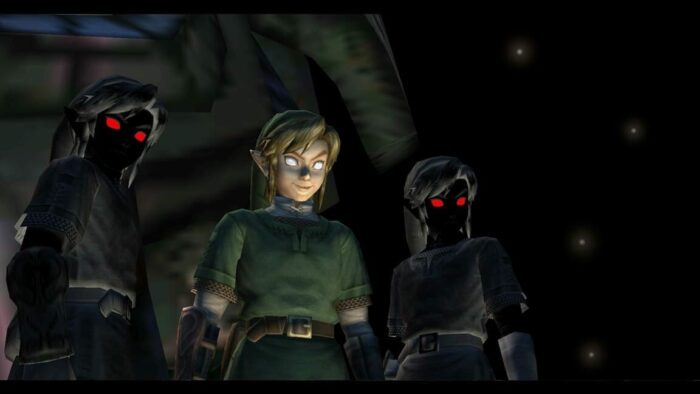Ocarina of Time, Majora’s Mask and Twilight Princess are three Legend of Zelda titles that have a line that runs through them in both form and content. To me, they’ll always be the Triforce of Zelda games. Wind Waker was released in between the last two but differs in many ways, mostly due to its radically different art design. Breath of the Wild also took the series to a whole new level later on but as of this moment, it stands alone. Due to lockdown and having an abundance of time on my hands, I had an extremely rare opportunity to play all three back-to-back.
I know these games well and only had to look up one or two things to finish them all, meaning I was able to breeze through and complete them in about nine days. What was interesting is that all three worlds vary in size drastically but each took approximately three days for me to complete. What I also noticed when jumping from one title to the next was that each had its own strengths and made it nearly impossible for me to choose a favourite. Opinions seem to differ wildly on Zelda games; one person’s best is another’s weakest and some prefer the 2D offerings for older consoles and various handheld systems, but let me make my case for these three.
Firstly, the appeal for me of the Zelda series is their cinematic qualities and this is what draws me to the 3D versions and these three above the rest. I feel like they’re the games that make you feel like you have control of a good film, mainly due to their incredible scripts, haunting music, and atmospheric worlds. As film and music are my greatest passions, this is why I’m so drawn to these titles in particular. Ocarina of Time was the first I played and the one I hold the most nostalgia for. Therefore, it’s the game I have the strongest connection with and will always have a special place in my heart.
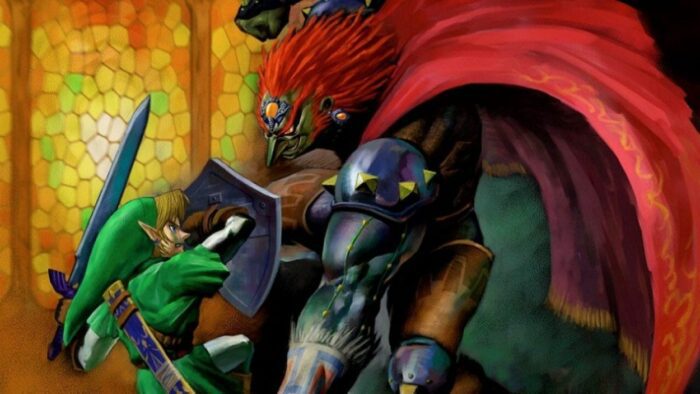
It’s biggest strength is that of the three, it’s the most epic in terms of story. Only in this game do you grow from being a child to an adult and traverse time between these periods whilst saving the world. Not only that but in your hibernation between the two states, the land of Hyrule has gone to hell, literally in certain areas such as the main castle town. It’s also only in this story that Link gains access to the Sacred Realm, where the legendary Triforce resides, the treasure that grants one the power to reorder the world however they see fit. Your job when you awaken from your slumber as an adult is to awaken five sages, whilst returning peace to the land.
These sages, along with Zelda are the only ones with the power to lock the treacherous Ganondorf away for the long haul and their inclusion adds a mythical, almost religious element that’s mysterious and alluring. Most of them also happen to be individuals that Link has made a connection with during his childhood, making his rescue of them and their awakenings even more meaningful. During the ending of the game, it’s when the music builds and all of them appear together on top of Death Mountain that never fails to give me goosebumps.
They take a last look at the land they called home before presumably ascending to a higher plane of existence, leaving behind a young Link and Zelda who have been returned to their original time. They reunite again as children, not knowing how much each will remember about their previous lives. There aren’t many films that pack an emotional punch as powerful as this final scene we’re left with and it’s mainly thanks to Writers Toru Osawa and Kensuke Tanabe. It’s their story along with all the amazing gameplay elements that provide that added layer of magic. If you want more detail on this title, you can check out my full article about it.
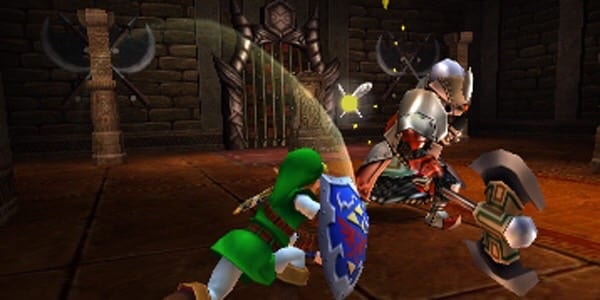
In Majora’s Mask, the story leads almost straight on from this epic tale and we return to a Link who seems a bit lost and despondent. Whilst on what seems a hopeless search for his companion from the previous story, he’s attacked by three outcasts in the woods. A Skull Kid with a striking mask and his two fairy companions lead Link on a chase when they steal his horse Epona and then down the rabbit hole, literally. Just as Alice found Wonderland, Link finds himself in a world that’s a dark, twisted version of the previous one he knew with alternate versions of many of its people as well. However, in this new land called Termina, magic has a much bigger presence and there’s a strong element of the surreal with undertones of tragedy.
Masks play a big role in the story and the gameplay, allowing Link to transform into many different forms and help the people of this world in various ways. This makes the game more original and intelligent than its predecessor. The world is much smaller than the previous one but the objective is more focussed on side quests and character interactions than it is about saving it, although your overall mission is to stop the moon falling into the world and causing the apocalypse by releasing four giants who can hold it up. This also sounds like something straight out of a fairytale or a Studio Ghibli film but fits perfectly with the dream-like tone.
The mask the Skull Kid wears is full of evil power, as an ancient tribe used it for their hexing rituals and then hid it away when it became too powerful. If that doesn’t sound ominous and intriguing, I’m not sure what does. Due to being an unlikeable, vexing creature and acting out after losing the few friends he had, the Skull Kid was banished from this Wonderland to the world above. It’s here that he mugged the wrong salesman and became the puppet of the eponymous mask. He then proceeded to cause as much chaos across the land of Termina as possible and did a good job of it too. It’s no coincidence that the best ocarina song in the game is called “The Song of Healing.”
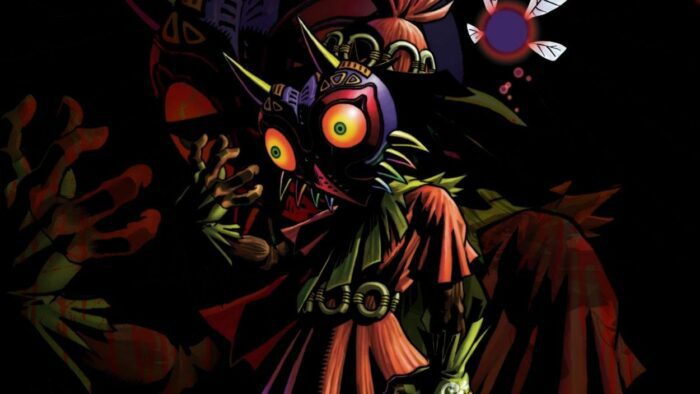
You use this beautifully melancholic tune to literally ease the pain and sorrow of the population of this land. The most significant example is in the haunted Ikana Canyon, where a father and her young daughter live and have fallen victim to the walking dead who wander around their music box house (no, really). It runs by water wheel and usually plays an eerie tune to stave them off but due to the Skull Kid’s interference, the water flow has stopped and left them defenceless. As a result, the father has begun to transform into a zombie himself. After you return their home and the father to normal, he has a long embrace with his daughter and you leave without saying a word and don’t encounter them again unless you purposely make a point to return to their home.
This in itself portrays the selfless heroism of Link’s character and is a poignant moment. Link never gets the thanks he really deserves and whether it’s Zelda, Tatl or Midna, one of them usually just gives a simple, emotional “thank you,” clearly knowing that this isn’t an appropriate response to all he has done. This never phases him though, this isn’t what he does it all for, as he’s a true hero. Like with the ending to the previous game, the best moment in this one is when the music builds and you see the daughter running up to her father and he lifts her into the air, bouncing her up in his hands in a great shot of the canyon. The game’s personal moments like this are just as powerful as the mythical ones from the previous title, albeit in a much different way.
This is capped off with a killer reveal from the Skull Kid… that he’s a very minor character you interacted with in at the very start of Ocarina of Time. Mind = blown. We were told in that game that Skull Kids are what children lost in the woods turn into and adults also become a more grown-up version called a Stalfos. This means that the Skull Kid must have had a hard life before the events of Majora’s Mask, adding another layer of tragedy and sympathy to this great villain. Major credit is due to Mitsuhiro Takano, Shigeru Miyamoto, Yoshiaki Koizumi for writing an even more compelling story and characters than the monumental Ocarina of Time. If you want more information about this title, read the excellent piece my colleague Collin Henderson wrote on it.
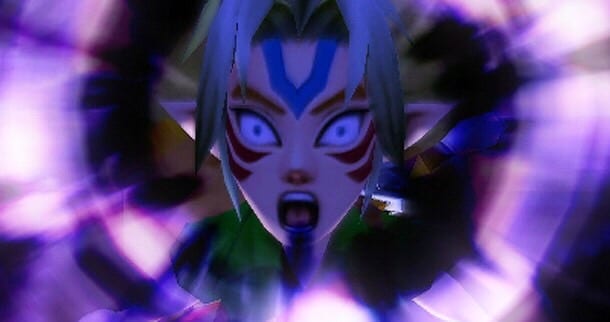
This brings us to Twilight Princess. Having not invested in a GameCube at the time (although I did play Wind Waker at a friend’s house), I really skipped straight to this title from Majora’s Mask and the leaps and bounds the gameplay and graphics took were breathtaking and still hold up well to this day. When I first played the game, I couldn’t put it down. It plays like a dream and therefore feels like one as well. The mechanics are so smooth, everything from the motion controls to a Link who can run faster and having Epona from the start all feel great. It all adds to a slick, clean journey through the narrative.
Everything in this game is on a grander scale, from Link’s home to the enormous Hyrule Castle. Hyrule Field is also separated into four parts, each as large, if not bigger than the one in Ocarina of Time. This is a good scale to measure its size in comparison. Along with this come numerous new weapons and gadgets to obtain as well as being able to do many things that just weren’t possible in the N64 titles. I’m talking about activities such as sumo wrestling, snowboarding, jousting on a massive, stone bridge and riding on top of a giant, flying, dragon-like creature. These are just some of many new abilities as well as many ace sword-fighting techniques and being able to transform into a wolf.
I’ve heard some criticism about this last ability but personally love it in both concept and functionality; it fits with the tone of the game perfectly. Although its gameplay is perhaps this title’s strongest element, it’s story also continues the high standard set by the previous two. The narrative is built around the concept of a dark, alternate dimension that exists parallel to Hyrule called the Twilight Realm. Stranger Things owes a lot to this game as it directly takes this idea and its logistics, even the particles that float in its air space and the Demogorgon highly resembles the creatures that inhabit the Twilight.
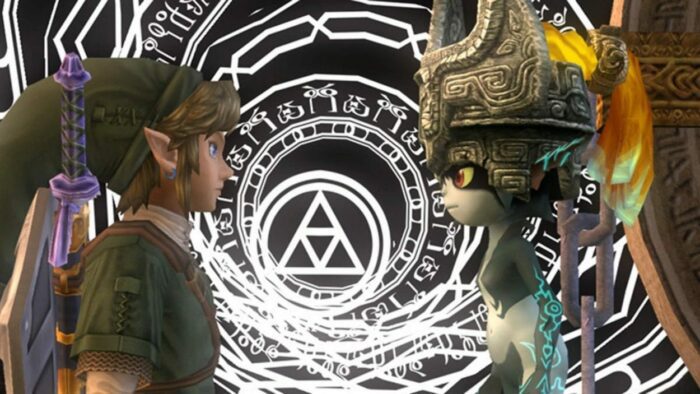
This realm is threatening to take over the dimension of light, after Ganondorf was banished there as a last resort, as it’s where the worst criminals were sent to as punishment. What the sages who sent him didn’t realise is that he would feed off the inhabitants’ hatred and anguish, rejuvenating him and enabling his return. The history of the Twilight Realm is so intriguing, as it was created when some interlopers with magical abilities tried to take over the world and were sent there by the three goddesses of the Triforce. The cutscene that explains this origin is particularly brilliant, with its use of Twin Peaks-like doppelgängers and cinematography, it’s my favourite one in any Zelda game.
When you’re in parts of Hyrule that have been covered by Twilight, it’s eerily serene, only surpassed when you enter the Twilight Realm itself. It’s a darkly beautiful, neon-tinged world that’s more cool than it sounds. The game also has its fair share of good character interactions, especially with Midna, the Twilight Princess who was with you through your whole journey, unbeknown to Link. Zelda plays a bigger part than in other titles and Link has a childhood sweetheart too. His connection to his home village and his people feels genuine and when he becomes the hero of destiny, it’s most impressive when he encounters them again on his travels and they see his transformation.
Writers Aya Kyogoku, Takayuki Ikkaku, Mitsuhiro Takano and Eiji Aonuma do an amazing job of balancing all aspects of the story, plus the scale and range of this game’s world makes it the most cinematic of all three titles. Moments such as those with the Great Light Spirits, climbing to the Mirror Chamber atop a Colosseum-esque structure and reaching the pinnacle of Hyrule Castle to face Ganondorf are unparalleled. If you want to know more about this game, check out my colleague Connor Cable’s article. It’s these aspects along with the flawless and fun gameplay that leads me to think that this game is my logical favourite.
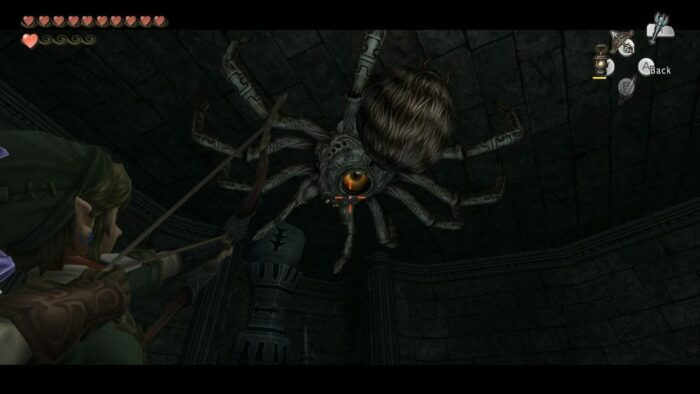
However, the deep, touching story and characters of Majora’s Mask are undeniable. Also, the fact that the team behind it created it in only two years, makes me then lean towards this title. Especially when you consider that Ocarina of Time took seven years to develop. Plus, its stunning moments, such as the trippy final moon area, with its savvy symbolism and disarming dialogue, are perhaps the series’s greatest ever motifs. The original 3D Zelda also remains in the running though, due to its classic, grand story and being the blueprint for which the other two are based on. It also boasts mine and many others favourite boss in the form of Dark Link, a simple yet effective shadowy reflection of yourself to spar with and try and outmanoeuvre.
It’s like deciding which part of the Triforce is best; power, wisdom or courage? They all have their merits. This in essence is the true beauty of the Legend of Zelda franchise as a whole. It’s one of the only series that can offer different but consistently brilliant qualities from one game to the next. I honestly can’t choose a definitive favourite between these three as they each have their different strengths and I would agree if anyone said any one of them was the best. One thing I can say for sure is that these three Zelda titles have incredible stories and the Writers deserve more credit than they receive. It’s easy to be drawn to gameplay and the technical aspects but these games wouldn’t be half as good without their film-standard, compelling narratives.
